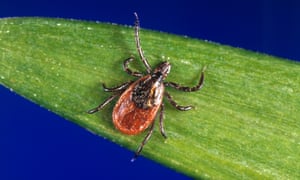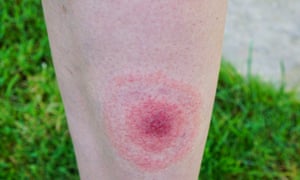Forget Ebola, Sars and Zika: ticks are the next global health threat
Ticks carry a wide array of pathogens – and environmental changes mean they are spreading

Humans have faced numerous attempts to challenge our dominance on planet Earth , and from the Black Death to the Spanish flu, we have weathered them all. However, since the start of the 21st century, with its trend towards global interconnectedness, these onslaughts are ever-increasing. In the past 17 years we have battled Sars, the Ebola virus, Mers, and more recently the mysterious mosquito-borne Zika virus. These diseases seeming to appear from nowhere and rapidly ravage our populations. One commonality is that they almost always originate in animals before jumping across to people, and few parasites are as good at jumping between animals and people as the tick.
Ticks could be best described as the used syringes of the natural world due to their promiscuous feeding habits. Most ticks go through three stages in their lives and feed on a different host at each stage, whilst simultaneously collecting hitchhiking microbes in their blood meals. Ticks also have one of the widest distributions of any vector on Earth – they can be found on every continent, including frigid Antarctica. This combination of ubiquity and a bad habit for accumulating pathogenic microbes make ticks some of the most dangerous vectors on the planet.
So why ticks? And why now?
Partly, it’s because ticks have been understudied for so long that only recently have we begun to realise just how much they affect our health. It took until 1975 for the infamous Lyme disease even to be formally described, and today the list of microbes found within ticks grows ever larger every year as numerous new species are discovered.

In short, our manipulation of the environment has set the stage for a tick-driven health crisis.
Ticks can carry an extremely wide array of human pathogens, including bacteria, viruses, and protozoa. Within the long list of human ailments caused by ticks, several dangerous diseases stand out.
Babesiosis is an emerging tick-borne disease caused by a protozoan called Babesia, a species related to the microbe which causes malaria. The disease is rarely tested for by doctors and the global levels of human infection are unknown, although some researchers believe that they may be much higher than present rates of diagnosis indicate. Infections can be highly variable, with about a quarter of infected adults showing no signs of the disease, while others will die from the infection. In truth the disease is still poorly understood in humans, which is compounded by the fact that several species of Babesia cause the disease and the signs and symptoms can be wide-ranging and often include fever, fatigue, anaemia, and nausea – all common features of other illnesses.

While only discovered in 2009, SFTS virus (severe fever with thrombocytopenia syndrome) has sparked widespread fear through much of Asia, especially in Japan where 57 people have died of the disease since 2013. Signs of the disease can range in severity from relatively mild, like fever and diarrhoea, to severe, which can include multiple organ failure. The fact that the epidemiology of the disease is so poorly known makes predicting and controlling its spread difficult. It is also known to be carried by at least two cosmopolitan tick species which are spread throughout the world from the UK, to the US, and even Australia. That might sounds bad enough, but things are even worse: although the disease typically gets to humans via a tick, from there it can spread to other humans or their pets and back again into ticks who feed on infected hosts.
Ticks are ubiquitous, dangerous, and are coming into ever greater contact with us. We must recognise that the next public health crisis may come from our backyards rather than a remote equatorial jungle in Africa or Asia.
No comments:
Post a Comment